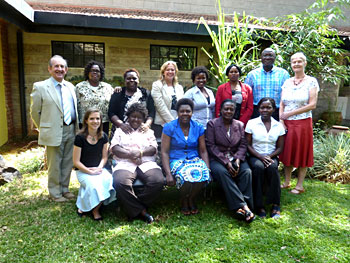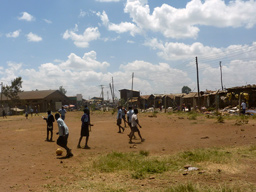ARCHIVE: This material is no longer maintained and should be viewed for reference only
Summary
The key research question asked by the gender project in East Africa is: what keeps girls in school against the odds? In seeking an answer to this question, the research team is gathering evidence from girls and boys in primary schools, from teachers, headteachers and district education officers, and from adult women who themselves struggled against the odds to continue their education and become successful career women. A second stage of the project involves partnerships across academic, government and voluntary organisations in order to develop research and intervention initiatives which help to foster retention and transition to secondary education.
Research team

The photograph shows the research and advisory team at a workshop in Nairobi in February 2011. From left to right , standing, are: Mike Younger (CCE), Mercy Musomi (Girl Child Network), Jane Rarieya (Aga Khan University Institute for Educational Development, Dar es Salaam, Tanzania), Alicia Fentiman (CCE),Susan Kiragu (CCE), Pamela Apiyo (Forum for African Women Educationalists, Kenya), Emmanuel Kamuli (UNICEF, Uganda) and Molly Warrington (CCE). Seated are: Sarah Shucksmith (independent researcher), Alice Merab Kagoda (Makerere University, Uganda), Martha Muhwezi (Forum for African Women Educationalists, Uganda), Resty Muziribi (Ministry of Education and Sports, Uganda) and Jane Afoyocan (UNICEF, Uganda).
Background
Both the Kenyan and Ugandan governments formally recognise gender equality as central to the attainment of the Education for All and Millennium Development Goals, and both governments have put in place various initiatives to support this aim. Indeed, considerable improvements have been shown in both countries with respect to gender parity in enrolment in primary schools. Yet, as UNESCO's 2010 EFA Global Monitoring Report shows, boys' enrolment in secondary education still outstrips that of girls, with girls' enrolment relative to that of boys continuing to fall throughout secondary schooling.
.jpg) Photograph: Chart showing male and female attendance by age and class in a Ugandan partner school.
Photograph: Chart showing male and female attendance by age and class in a Ugandan partner school.
The reasons why girls drop out of school across many parts of Sub-Saharan Africa are well-known. There is, however, little understanding over why some girls, despite coming from poor backgrounds, or from families or communities where schooling is under-valued for cultural reasons, nevertheless do strive to stay in school and continue their education. At its first meeting in Cambridge in June 2009, the project team, drawing on academic understanding, and on the first-hand knowledge of voluntary section organisations in Uganda and Kenya, decided to focus attention on the question: 'what keeps girls in school against the odds?'
Further details on the background to the project and its development and partnership approach are available in Gender in East Africa: Report No.1
 Photograph (left): Children 'against the odds' at school in Korogocho, Nairobi
Photograph (left): Children 'against the odds' at school in Korogocho, Nairobi
